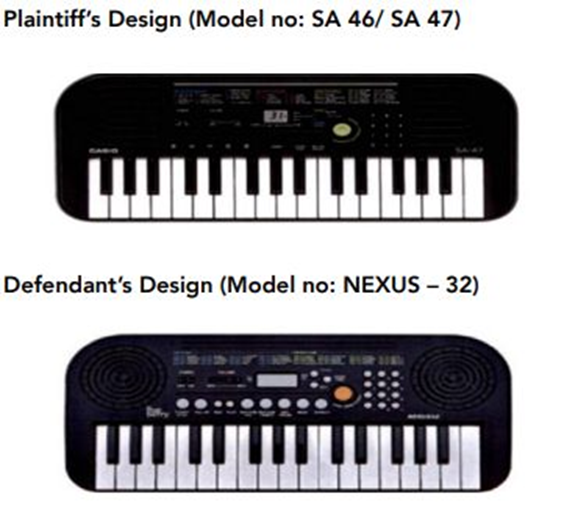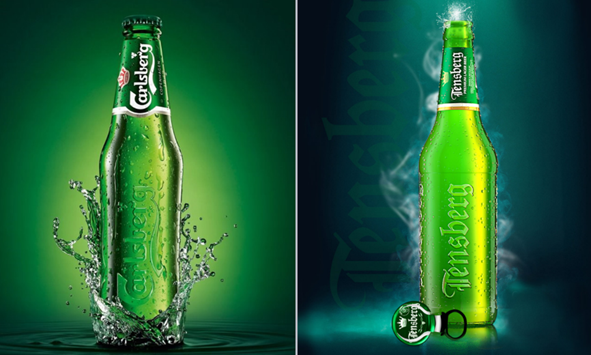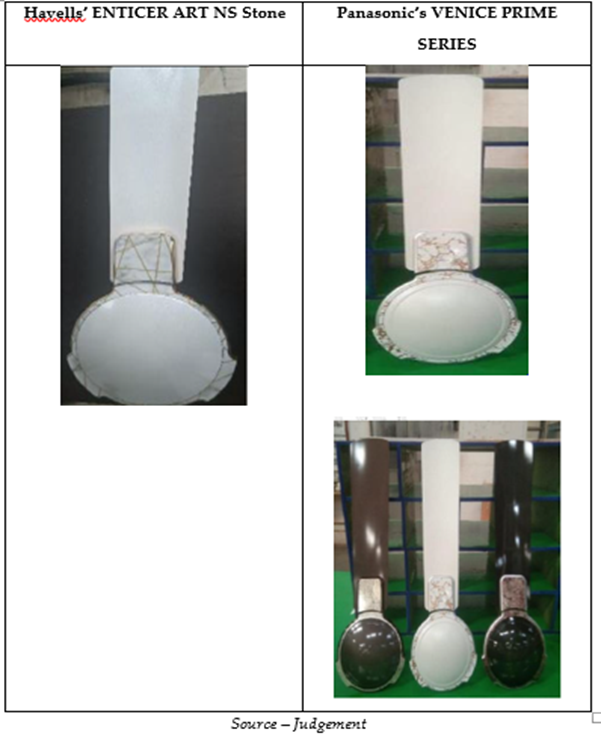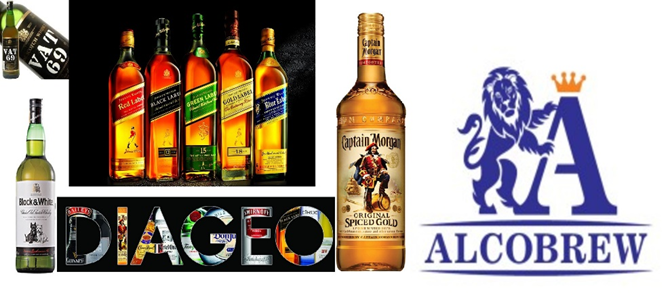
The complex interplay between trademark and design law in the context of intellectual property law has been examined by courts on several occasions. This piece of work examines the passing-off actions alongside design infringement cases, including their reasoning, identified flaws, and the evolution of their stance over time, highlighting specific cases to elucidate the current legal position on this matter.

Recently in a 2023 case of Casio Keisanki Kabushiki Kaisha vs. Riddhi Siddhi Retail Venture[1], the matter of the intersection between trademark and design arose again. In this case, the Delhi High Court upheld an interim order restraining the defendant from selling musical keyboards with a design deceptively similar to Casio’s. The court found that the defendant’s keyboards closely resembled Casio’s design.
Casio had registered its keyboard design as “Blueberry” in 2009, which had become strongly associated with the brand. The plaintiff argued that the defendant’s keyboard design, sold under the brand “Nexus32,” was nearly identical to theirs and had caused confusion among consumers.
The court determined that the defendant’s keyboard design was an obvious imitation of the plaintiff’s, as per the Designs Act. The burden of proving lack of novelty or originality was on the defendant, and since they couldn’t provide evidence of prior publication, the court held that the plaintiff’s design was not liable for cancellation.
The Delhi High Court upheld the injunction against the defendant, finding their keyboard design deceptively similar to Casio’s and rejecting claims of lack of novelty or originality.
Under the Trademark Act of 1999[2], a trademark is defined as a mark that can be represented graphically and is capable of distinguishing the goods or services of one person from others. This definition explicitly includes the shape of goods as a registrable trademark.
In contrast, the Design Act of 2000[3] defines “design” as limited to the features of shape, configuration, pattern, ornament, or composition of lines or colors applied to any article. Design registration requires novelty and prohibits prior publication. There is no provision for common law rights or passing-off actions for design marks, and infringement remedies are limited to the statutory framework outlined in Section 22[4] of the Design Act.
This creates an overlap between design and trademark, where shapes can serve as both. Trademark registration does not have the same novelty requirements as design registration. Courts have provided varying responses regarding the coexistence of a passing-off action alongside design infringement.
Examining Evolving Court Responses and Key Cases
In the 1983 case of Tobu Enterprises v Meghna Enterprises[5], the court made it clear that when both parties have registered designs, they cannot seek injunctions or damages under two statutes simultaneously. The plaintiff claimed both design infringement and passing off by the defendant, but the court ruled that the Designs Act, 1911, does not allow for a passing-off claim. Such a claim is only permitted under the Trademark Act, of 1958. The court emphasized that the right to “passing off” is a common law right but is subject to specific statutory provisions. Since the Designs Act did not provide remedies for passing off, no injunction could be granted on those grounds.
Furthermore, in M/S Micolube India Limited v Rakesh Kumar Trading As Saurabh Industries & Ors[6], the court made the following observations:-
Regarding Infringement of Registered Designs:
- A lawsuit for design infringement is not allowed under the Designs Act when both parties are registered proprietors, and the design registrations cover the same shape and configuration of an article.
Regarding Passing Off for Shape Protection:
- Passing off cannot be used to enforce rights for shape protection under the Designs Act. The Act’s purpose is to provide limited protection without extending it to shape protection.
Regarding Joining Passing Off with Design Infringement:
- Passing off can be used alongside design infringement claims, but only in cases related to elements like trademarks, trade dress, or trade-related features other than the shape of the goods covered by the design registration.
Exceptions to Passing Off for Shape Protection:
- Passing off for shape protection remains available during and after the design monopoly period if the shape isn’t covered by the design’s novelty claim. However, after design expiration, if the shape is part of the novelty claim, it becomes part of the public domain and cannot be protected through passing off.
However, in the case of Mohan Lal v. Sona Paint & Hardwares[7], a three-judge bench held the following:
- Suit for Registered Design: A person with a registered design can file a lawsuit against another person who also has a registered design.
- Passing Off with Registered Design: If someone with a registered design uses it as a trademark and meets the necessary requirements, they can take legal action for passing off. This means they can sue if someone else is using their design as a trademark.
- Composite Suit: However, you cannot combine a lawsuit for registered design infringement with a passing-off action. They need to be separate legal actions.
In simpler terms, if a person has a registered design, then that person can take legal action against someone else with a registered design or if they are using their design as a trademark. But if the person wants to do both, then they have to file two separate lawsuits: one for design infringement and another for passing off.
The key difference between the two cases lies in the approach to combining a registered design infringement claim with a passing-off claim. In the Micolube India case, it was clarified that there is no provision for passing off under the Designs Act, whereas, in the Mohan Lal case, the court allowed for separate actions but not a single composite suit.
But in 2018, a five-judge bench of the Delhi High Court, in the Carlsberg Breweries v. Som Distilleries And Breweries case[8], overturned the previous Mohan Lal precedent. The new ruling allowed a plaintiff to combine two legal claims in a single lawsuit: one for the infringement of their registered design and the other for the defendant’s passing off of their goods.

The central issue was whether a composite suit could include both the claim of design infringement and the claim of passing off in one legal action. The court determined that the court in Mohan Lal had misunderstood the previous precedents that it had relied on and that those cases were not addressing the joining of causes of action in a single composite suit. According to the court’s ruling, when claims of design infringement and passing off arise from the same sale transaction, they involve similar legal and factual questions. Therefore, to prevent unnecessary duplication of legal proceedings, it’s appropriate to combine these two causes of action into one lawsuit. This decision streamlines legal proceedings by allowing the combination of design rights and passing off claims in such cases.
In the case of Symphony Ltd. v. Thermo King India Pvt Ltd [9]., Symphony Ltd. filed a lawsuit against Thermo King India Pvt Ltd., primarily addressing the alleged infringement of Symphony’s design rights and trademarks in their air cooler products. On the other hand, in Crocs Inc. USA v. Aqualite India & Others [10], the court clarified that a registered design cannot serve as a trademark. However, if additional features beyond the registered design are used as trademarks and have built up goodwill, these additional features can be protected as trademarks. These cases collectively illustrate the evolving landscape of intellectual property law in India.
A slightly different case, Havells India Ltd v. Panasonic Life Solutions India Pvt Ltd [11], challenged whether a single lawsuit can encompass both passing off of trade dress and design infringement, with the dispute arising from similar fan designs.

The plaintiff, having design registration for its Enticer ceiling fans, sought an injunction against the defendant’s Venice Prime fans, alleging similarity. The court ruled that combining passing off and design infringement claims for the same product in a single lawsuit is permissible, following the Carlsberg precedent. It favoured the plaintiff, granting an interim injunction against the defendant’s Venice Prime fans.
In Diageo Brands v. Alcobrew Distilleries[12], Diageo Brands, known for “Johnnie Walker” whiskey, held design rights for their unique bottle shape. They sued Alcobrew Distilleries, alleging trademark and design infringement due to Alcobrew’s use of the “OFFICER’S CHOICE” mark and a similar bottle design.

The court assessed trademark distinctiveness, bottle design similarity, and potential consumer confusion. Recognizing the reputation of the “JOHNNIE WALKER” mark and bottle design, the court ruled in favor of Diageo Brands. They issued an injunction against Alcobrew and awarded damages.
This case underscores the need to protect both trademarks and designs and the legal recourse available to brand owners when their intellectual property faces infringement in the alcoholic beverage industry.
Together, these cases offer valuable insights into the complexities and evolving nature of intellectual property law in India. They cover a range of issues, including the permissibility of combining claims in a single lawsuit, the distinction between design rights and trademarks, and the protection of unique product features in a competitive market.
[1] Casio Keisanki Kabushiki Kaisha D/B/A Casio Computer Co. Ltd. v. Riddhi Siddhi Retail Venture, (2023) 94 PTC 225
[2] The Trademark Act,1999(Act 47 of 1999), S. 2(1)(zb)
[3] The Design Act,2000, S.2(d)
[4] The Design Act,2000, S.22
[5] Tobu Enterprises v Meghna Enterprises,(1983) PTC 359
[6] Micolube India Limited v. Rakesh Kumar Trading as Saurabh Industries & Others, 2013 (55) PTC 1[DEL][FB]
[7] Mohan Lal v. Sona Paint & Hardwares,2013 (55) PTC 61[DEL][FB]
[8] Carlsberg Breweries v. Som Distilleries And Breweries,C.S.(COMM) 690/2018 & I.A. No.11166/2018
[9] Symphony Ltd. v. Thermo King India Pvt Ltd., CS (COMM) 321/2018
[10] Crocs Inc. USA v. Aqualite India & Others, 2019 (78) PTC 100[DEL]
[11] Havells India Ltd v. Panasonic Life Solutions India Pvt Ltd,[CS(COMM) 261/2022]
[12] Diageo Brands v. Alcobrew Distilleries, [CS(COMM) 30/2022].

Aditi Singh
Author
I’m in my fourth year, studying B.A. LL.B.(Hons.) at the National University of Advanced Legal Studies(NUALS). I have a keen interest in intellectual property and technology laws, particularly the evolving legal landscape. Simultaneously, I also closely follow constitutional jurisprudence, with a focus on women’s rights. My commitment extends to staying informed about climate affairs worldwide. I enjoy legal-themed movies, diverse reading, and engaging in spirited discussions on current affairs and geopolitical issues with friends.
Leave a Reply